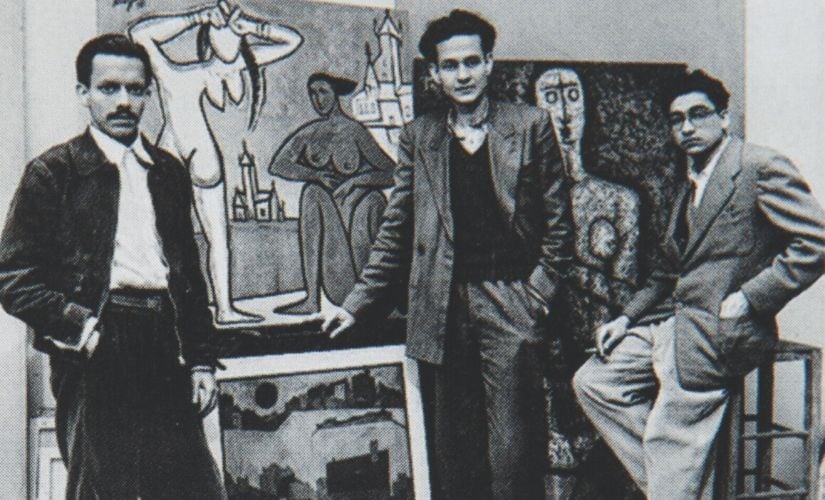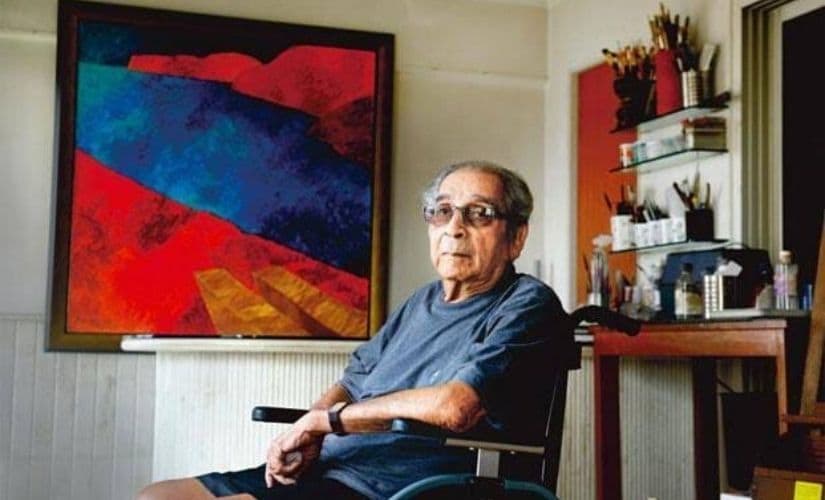“You need the mind of a mathematician and poet to be a painter,” Akbar Padamsee, one of India’s greatest post-Independence artists, once said in an interview to Christie’s. Indeed, Padamsee’s vast oeuvre is meditative like a verse, and at the same time, it is also born out of the methodical precision of a mathematician’s mind. With his death at the age of 91 , which was announced on Monday, a long and illustrious chapter in India’s post-colonial art history has come to an end. Mumbai-based auction house Saffronart has rated him among the top five highest selling modern Indian artists, along with VS Gaitonde, FN Souza, Tyeb Mehta and SH Raza. With a career spanning over five decades, the Mumbai-born artist became known for his prolific output across a diverse range of mediums and genres. These include landscapes, still-lifes, portraitures, including head studies, nudes, prophet and Christ figures, and, most importantly, his famous metascapes, grey works and mirror-images. Works in oils, plastic emulsion, water colours, drawings, photography, print-making, sculptures, computer graphics and even film-making form part of the corpus of his work. [caption id=“attachment_7885911” align=“alignnone” width=“825”]  From left to right: FN Souza, SH Raza and Akbar Padamsee in Paris. Image courtesy: Raza Foundation[/caption] In particular, Padamsee’s mystifying oils, water-colours and drawings reflect his mastery over so many aspects of the composition, such as form, space, and colour. Often, his unique pictoriality blurred the lines between abstraction and figuration, leaving many things unsaid. A student of painting at Mumbai’s Sir JJ School of Art and one of the members of the Progressive Artists’ Group, the artist’s cosmopolitan nature and modernist outlook can be attributed to his stay in Paris. While travelling in Europe, the young Padamsee was influenced by the works of Renaissance greats Giotto and Masaccio, Dutch master Rembrandt, Fauvist painter Georges Rouault, and the Swiss-born Paul Klee, who, in his own words, helped him understand how to use colour. But the highlight of his trip to Paris was a prize awarded by Andre Breton, co-founder of the surrealist movement, for one of his earliest paintings from the prophet series. Colours explode in Prophet 1, which was painted in Paris in 1952, but the figure of the holy man in the work is imbued with stoic silence. While the prize also had Akbar Padamsee’s fellow progressives Souza and Raza among the applicants, its announcement in the name of an unknown, younger artist— only 22 years old — reportedly surprised many. In the same year, he had his first-ever solo exhibition, at Galerie Saint Placide, Paris. Two years later, his first exhibition in India was held at Jehangir Art Gallery, Mumbai, which eventually landed him in a court case as two of his paintings showed a nude couple. On 9 January, Mumbai’s Priyasri Art Gallery will revisit the oft-quoted incident from the artist’s life, through an exhibition titled ‘Judgement in the Trial of Akbar Padamsee’. Also read: Akbar Padamsee: Consummate colourist, caring peer, anti-censorship champion and ever-evolving artist In an interview following Padamsee’s death, Kamini Sawhney, curator of Mumbai-based Jehangir Nicholson Art Foundation (JNAF), which has several of the artist’s works in its collection, said: “During a career that explored a wide range of mediums, Akbar Padamsee managed to remain fiercely experimental and individualistic. With his passing we have lost one of the last few pioneers of Indian modernism.” From 9 January, JNAF will be hosting a three month-long exhibition of Padamsee’s works, which are drawn from the foundation’s collection. The exhibition’s poster shows an ailing, bald and naked man, painted against a background of a deep shade of red, and brown. Is he lost in a reverie, dead, or fast asleep? Is he a common man or a seer? It is hard to tell. While the exhibition was announced in December 2019, Padamsee’s passing away ahead of the opening is expected to garner more attention than expected. For Sawhney, the exhibition is a tribute to the artist, while adding that Padamsee’s process of creation is deeply introspective, bringing into focus “thoughts and ideas that are almost spiritual.” The spiritual side of him remained alive, as it were, until he breathed his last, at an ashram retreat in Coimbatore. Padamsee was also deeply interested in Sanskrit language and texts. As the news of his death became public, critics, artists and curators recalled their conversations with him, which were peppered with references from the ancient language. In the words of artist Gulammohammed Sheikh, who has been following Padamsee’s works since his student days at MSU Baroda in the 50s: “Akbar’s quest to delve deeper into the philosophies of the Indian tradition in the last three to four decades made him a student of Sanskrit. He was known to quote from a variety of scriptures he had learnt from the original, often even in conversations.” One such meeting took place in 2005, when Delhi-based author and curator Uma Nair visited Padamsee’s studio at his apartment in Mumbai. Nair recalled sitting with the artist in front of a metascape he had just finished. When he spoke of the work, he chanted Sanskrit shlokas from the epic play Abhigyan Shakuntalam, “like a Sanskrit sage.” “Suffused with colours you saw nature and spiritual fervour at its zenith. Among all his works, I loved the Rooftop series,” Nair added. [caption id=“attachment_7885981” align=“alignnone” width=“825”]  Akbar Padamsee. Facebook/Sankhya-Art-Foundation[/caption] Enormous in scale and distinct for its pictorial vocabulary, Padamsee’s Rooftops canvas, along with other grey works, is considered one of the milestones of his career, in which his painterly style gravitated towards powerful monochromatic tones. Rooftops is the portrayal of a visibly urban landscape, while showing what looks like rows of houses stacked on top of each other, except the aesthetic of the work is less realistic and more ethereal. Speaking in the same interview to Christie’s from his studio in 2018, Padamsee explained his approach to the famed grey series: “I was not rejecting colour. It was an exploration of colour as quantities of black and white. It’s far more exciting for me as a painter to work in grey or sepia. The brush can move freely from figure to ground, and this interaction offers me immense formal possibilities.” Padamsee’s work is emblematic of several contradictions, just like the image of the bald man in the JNAF poster. In his work, there was the celebration of colour, and in his monochromatic experimentations a mysterious dilution of the same. This is juxtaposed with an austerity of form, pared down to the raw details, even in his nudes. Although his work commands a high price, he was known to give away his works and drawings for free or, as he did once, for a small amount of a thousand rupees, to the Faculty of Fine Arts, MSU Baroda, in the 1970s. “Akbar was a living representative of the inherent duality of life. The profane and the prosaic sat alongside the profound,” said Mumbai-based author and art consultant Anupa Mehta. In 2010, Mehta’s The Loft gallery opened an exhibition of Akbar Padamsee’s works. Titled “Body Parts”, the show featured Padamsee’s drawings, lithographs, photographs and oils on board. Stoic face studies, and sensuous nudes in photographs and drawings were part of the exhibition. The works showed the artist’s measured treatment of form, with a deft play of light in photographs and a magical arrangement of space against the criss-crossing lines of his drawings. Nearly overwhelmed with nostalgia about Akbar Padamsee’s work and the exhibition, Mehta continued: “When I look at the works, especially the nudes, they are like landscapes. There was a certain pristine sexuality. At the same time, there was an element of godliness, visible in the curvature of body, wave of form, and its sensual moulding. Padamsee was interested in form per se. He was a painter’s painter, a colourist par excellence.”
In particular, Akbar Padamsee’s mystifying oils, water-colours and drawings reflect his mastery over so many aspects of the composition, such as form, space, and colour. Often, his unique pictoriality blurred the lines between abstraction and figuration, leaving many things unsaid.
Advertisement
End of Article


)
)
)
)
)
)
)
)
)



